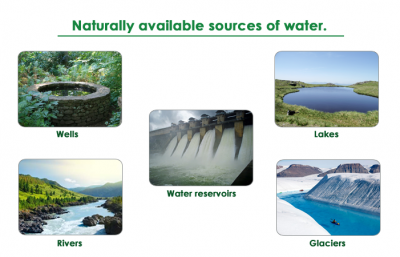Back to: PHYSICAL HEALTH EDUCATION JSS1
Welcome to class!
In today’s class, we will be talking about the sources of water. Enjoy the class!
Sources of Water

Water, a substance composed of the chemical element’s hydrogen and oxygen and existing in gaseous, liquid, and solid states. It is one of the most plentiful and essential compounds. A tasteless and odourless liquid at room temperature, it has the important ability to dissolve many other substances
However, there are two major sources of water which are surface water and groundwater. Surface water is found in lakes, rivers, and reservoirs. Groundwater lies under the surface of the land, where it travels through and fills openings in the rocks.
Ground Water:
Groundwater is water that is found underground within rocks. Its presence depends primarily on the type of rock. Permeable rocks have tiny spaces between the solid rock particles that allow water and other fluids to pass through and to be held within the rock structure. The layers of rock that hold groundwater are called aquifers.
Groundwater in an aquifer is replenished by rain and other forms of precipitation (any form of water, such as rain, snow, sleet or hail that falls to the Earth’s surface. The level of water below ground is called the water table. Groundwater can be extracted from wells or collected from springs.
Well-water:
Well-water as a source of water can be described by their depth, or by the way they are constructed. Most especially they use different types of the pump at the surface to raise the water.
The pump is usually used to retrieve water and it goes through an extensive filtration or decontamination process either naturally or chemically. There are two major types of well water
Shallow wells:
Shallow wells and boreholes usually have a depth of less than 30 m, although they can be as much as 60 m deep, especially in very dry areas of Ethiopia where the water table is low.
Wells can be excavated by hand if the soil is not too hard or the water table is high. Hand-dug wells have a relatively large diameter because they have to be wide enough for a person to be able to stand inside and dig.
Deep wells:
These are wells that have been sunk with drilling machines designed for constructing water extraction boreholes. These machines can penetrate through harder material that cannot be tackled by hand digging and can, therefore, pass through at least one impermeable layer of rock to a productive aquifer underneath.
Rainwater:
This is the source of water that comes from above the clouds, this water is very pure. Until it encounters something on it way down. However, if it is stored properly it may relinquish clean drinking water.
In regions where rainfall is abundant and frequent, rainwater can be a good source of water supply for individual, families and some communities. The storage of rainwater is particularly important in areas with a long dry season, or where spring water is difficult to obtain.
The term rainwater harvesting is sometimes used. It simply means collecting, or harvesting, rainwater as it runs off from hard surfaces and storing it in a tank.
Rainwater has several advantages. It is free, relatively clean and usually reliable, even if it rains only once or twice a year, a rainwater harvesting system can be easily constructed and maintained at low cost. Although mainly found in rural areas.
Surface Water:
Surface water is easily the most abundant supply of natural water. The downside is that most of the surface water on the planet is salt water so it is not ideal for drinking for most living species. Surface water does play an important part in our daily lives in addition to being a source of drinking water.
It is used to produce hydro-electric power as a clean energy source that is also renewable. Surface water is supplied by precipitation, springs and ice melting from higher elevations and glaciers.
Snowmelt:
Melting snow is another natural source of water when melted in great amounts can yield clean drinking water especially once boiled
Lake and River Water:
Lakes and rivers provide much water to wild animals and if cleaned and filtered properly it could become clean enough to drink for humans. Most countries with access to lakes and rivers use their water for human consumption. This source of water supply is usually regularly replenished by various weather events.
We hope you enjoyed the class.
Should you have any further question, feel free to ask in the comment section below and trust us to respond as soon as possible.
